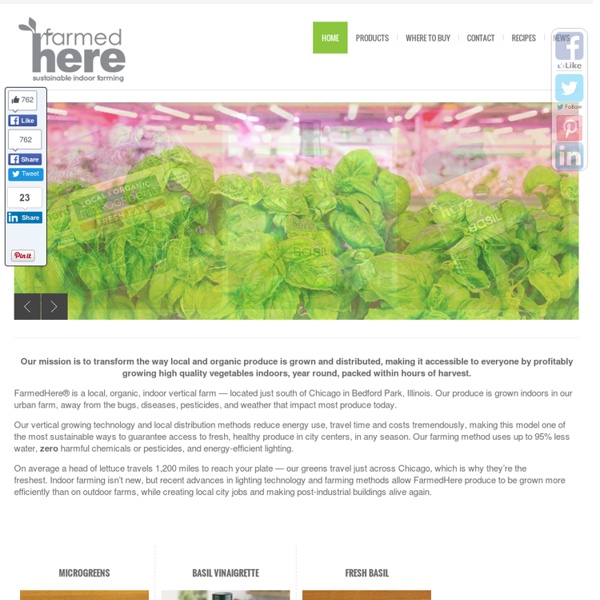In Newark, a Vertical Indoor Farm Helps Anchor an Area’s Revival
Scheduled to open this fall inside the new Ironbound site, AeroFarms projects it will reap up to 30 harvests a year, or two million pounds of greens, including kale, arugula and romaine lettuce, Mr. Rosenberg said. At that output, AeroFarms would be among the most productive vertical farms in the country, analysts say. Photo
WeFeedUs announces PA-based commercial aquaponics facility
Home / Scale Up / WeFeedUs announces PA-based commercial aquaponics facility Scale Up January 22, 2013AlgaeIndustryMagazine.com arlisle, Pennsylvania-based WeFeedUs, a sustainable resource management company developing a commercial scale sustainable operation integrating the production of produce, fish, algae and renewable energy, has announced it has constructed a commercial aquaponics facility. According to the company, the production of food will be driven by on-site managed aquaponics systems, Recirculation Aquaculture System (RAS), algae biomass production and green energy systems powering the facilities.
This Week in Virology - The Vertical Farm: Feeding the World in the 21st Century
Product Description "The vertical farm is a world-changing innovation whose time has come. Dickson Despommier's visionary book provides a blueprint for securing the world's food supply and at the same time solving one of the gravest environmental crises facing us today."--Sting Imagine a world where every town has their own local food source, grown in the safest way possible, where no drop of water or particle of light is wasted, and where a simple elevator ride can transport you to nature's grocery store - imagine the world of the vertical farm.
Friendly Aquaponics, Inc.
If you were asking yourself: “Is organic certification of aquaponics possible?” when you loaded this page, the answer is a resounding YES! My gorgeous wife Susanne got our farm’s aquaponics systems USDA Organically Certified in 2008.
Israel a vertical farming hot spot?
We’ll send in-depth vertical farming case studies straight to your inbox. Sign up here and make sure you don’t miss out. You know that feeling when a hundred disparate conversations all start linking together? That’s how I feel about Israel right now.
Urban Farming in Israel - LivinGreen
What is Urban Farming? Growing and processing Food products in urban areas. The growing takes place in flowerbeds within the city or outskirts of the city, on rooftops, vertical growing on walls (green walls), indoor growing and more. Vegetables and other greens can be grown by Individuals in their back yard or balcony and up to commercial growing systems.
WHAT IS VERTICAL FARMING?WHAT IS HYDROPONICS?WHAT ARE MICRO NUTRIENTS?ADVANTAGES OF VERTICAL FARMING? FOR PRELIMS AND MAINS GS PAP III
Ø Yes it's vertical because you are trying to grow more crops on a smaller land area and this usually means going upwards into buildings Ø It normally means that, instead of having a single layer of crops over a large land area, you have stacks of crops going upwards Ø It's also associated with city farming and urban farming Ø Who is "Dickson Despommier"? Ø Who is William Frederick Gericke? Ø Dickson Despommier, Columbia Microbiology Professor, is the Godfather of Vertical Farming
Vertical farming: Does it really stack up?
WHEN you run out of land in a crowded city, the solution is obvious: build upwards. This simple trick makes it possible to pack huge numbers of homes and offices into a limited space such as Hong Kong, Manhattan or the City of London. Mankind now faces a similar problem on a global scale. The world's population is expected to increase to 9.1 billion by 2050, according to the UN.
Can Cities Feed Their Inhabitants?
David Thorpe looks at the options A greenhouse developed by Priva, an international company that provides innovative solutions for the more efficient control of energy and water within indoor environments. There are three dominant trends to which cities and national governments must respond in order to secure food supplies for their people. First, between 1980 and 2011 the global population not dependent on agriculture doubled to 4.4 billion, and, according to the Food and Agriculture Organization this population is growing at a rate about five times that of the agriculturally dependent population. Second, the amount of agricultural land available for growing food is declining and will soon start to be adversely affected by climate change. Third, in 2011 agricultural subsidies in the world’s top 21 food-producing countries totalled an estimated US$486bn.
- City Farms, Parks and Boston: Let’s Grow Up
Vertical Farm, photo credited to Valcent via www.economist.com It’s been days since Edward Glaeser published his urban farm-bashing piece in the Boston Globe, but I’m still annoyed. Glaeser, a professor of economics at Harvard University and director of the Rappaport Institute for Greater Boston, managed to argue against farms in a way that could extend to urban parks, gardens, zoos, swimming pools, and most sidewalks. He also ignored some intriguing trends in making urban farming more efficient, a.k.a. the Vertical Farm. But before I give you a view from the roof, let’s consider what’s happening on the ground.



